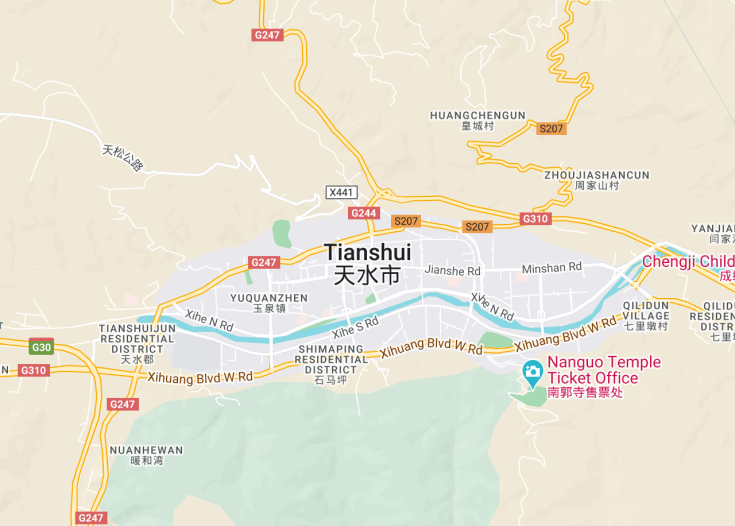Nestled in the northeastern part of Gansu Province, Tianshui is a gem steeped in history and natural beauty. This city, whose origins trace back to ancient times, serves as a vital link on the Silk Road, enriching its cultural tapestry. Visitors can explore the Maijishan Grottoes, a marvel of Buddhist art containing thousands of statues and frescoes. The area’s scenic landscapes, including the Fuxi Temple and the captivating Qinzhou district, offer tranquil yet enriching experiences. Tianshui not only captivates with its historical relics but also with its charming rural vistas and vibrant local life.
Check the local weather in Tianshui and dress accordingly; the region can experience significant temperature shifts, which might affect your travel comfort.
Consider visiting Tianshui during the Spring or Autumn festivals to experience the city’s rich traditions and lively celebrations.
Top things to do & see in Tianshui
Select the following sights and activities to discover best tickets and tours available in Tianshui.
Tianshui: Gateway to Ancient Grotto Art
| Country | China |
| Time in Tianshui | GMT+8 |
| Language spoken | Mandarin |
| Population | 3.5 million (2023 estimate) |
| Currency | Chinese Yuan (¥, CNY) |
| Airports | Mainjian Airport (23 mi / 37 km) |
Tianshui, located in Gansu Province, China, is an ancient city with rich cultural heritage. Known for its historical monuments and sites, Tianshui is a junction point between various Chinese historical periods. The city boasts a remarkable timeline, tracing back to the neolithic age. It played an essential role during the Silk Road era, serving as a crucial node in the network that facilitated trade and cultural exchange between the East and West.
One of Tianshui’s most famous attractions is the Maijishan Grottoes. These are a series of 194 caves cut in the side of the hill of Maiji Mountain. Filled with over 7,200 Buddhist sculptures and over 1,000 square meters of murals, these grottoes are a testament to the spiritual and artistic accomplishments of ancient cultures and are a popular destination for both domestic and international tourists.
Aside from its historical and cultural significance, Tianshui is also known for its natural beauty. Encircled by mountains and rivers, the city’s landscape is dotted with picturesque spots that offer tranquil respite from the bustling city life. Fuxi Temple, another well-known site, adds to the spiritual heritage and offers insight into the mythological origins of Chinese civilization, dedicating itself to Fuxi, a legendary ruler revered as the originator of fishing and trapping.
Where is Tianshui?
Tianshui is located in the southeast part of Gansu Province, central China.
Distances:
| Route | Distance by car | Time by car |
|---|---|---|
| From Lanzhou to Tianshui | 195 km | 2 hrs 35 min |
| From Xi’an to Tianshui | 363 km | 4 hrs 15 min |
What is Tianshui famous for?
Tianshui is notably famous for the Maijishan Grottoes, a stunning example of rock-cut architecture and Buddhist art, offering insight into China’s religious heritage from several dynasties.
History
Ancient Period (Before 581 AD)
Tianshui, one of the oldest cities in China, has a history tracing back to ancient times. It is believed that the city’s history began with the settlement of the Fuxi family, legendary progenitors of human civilization in Chinese mythology. Over time, Tianshui became an important stop on the Silk Road, facilitating trade and cultural exchanges between the East and West.
Imperial Era (581-1912)
During the dynastic periods, Tianshui’s significance as a political and military center grew. It served as a strategic point in various dynasties, including the Tang and Ming dynasties. Numerous historical figures, including famous generals and scholars, originated from this area, contributing to its rich historical tapestry.
Modern Era (1912-Present)
Transitioning into the modern era, Tianshui maintained its importance in regional politics and economy. Throughout the 20th century, the city underwent several developmental phases, modernizing its infrastructure yet preserving its ancient heritage, evident in its historic sites and continuing traditional practices.
Visit Tianshui
What to see and do in Tianshui, China
Exploring Tianshui offers a journey through both its ancient past and vibrant present. Key attractions include:
- Maiji Mountain Grottoes – a stunning complex of Buddhist sculptures and murals.
- Fuxi Temple – dedicated to the mythical progenitor of Chinese civilization.
- Tianshui Museum – showcasing local history and artifacts.
- Beidou Pavilion – offering panoramic views of the city and surroundings.
Cultural Festivities in Tianshui
Tianshui hosts numerous events throughout the year, celebrating its rich cultural heritage. Notable festivals include the Lantern Festival in early spring and the Fuxi Culture Festival in summer, both imbued with traditional performances, rituals, and local cuisine.
Best time to visit Tianshui
The optimal time to visit Tianshui is during spring (April to June) and autumn (September to November), when the weather is most pleasant and the natural scenery is at its peak, enhancing the exploration of historical sites and outdoor activities.
Is Tianshui worth visiting?
Tianshui offers a compelling blend of historical depth and cultural richness, making it a worthwhile destination for those interested in China’s ancient civilizations and scenic landscapes. However, its remote location and less modernized amenities compared to larger Chinese cities might pose challenges for some travelers. Overall, it is a destination that promises a unique and enriching experience for those willing to explore its historic charm and natural beauty.










